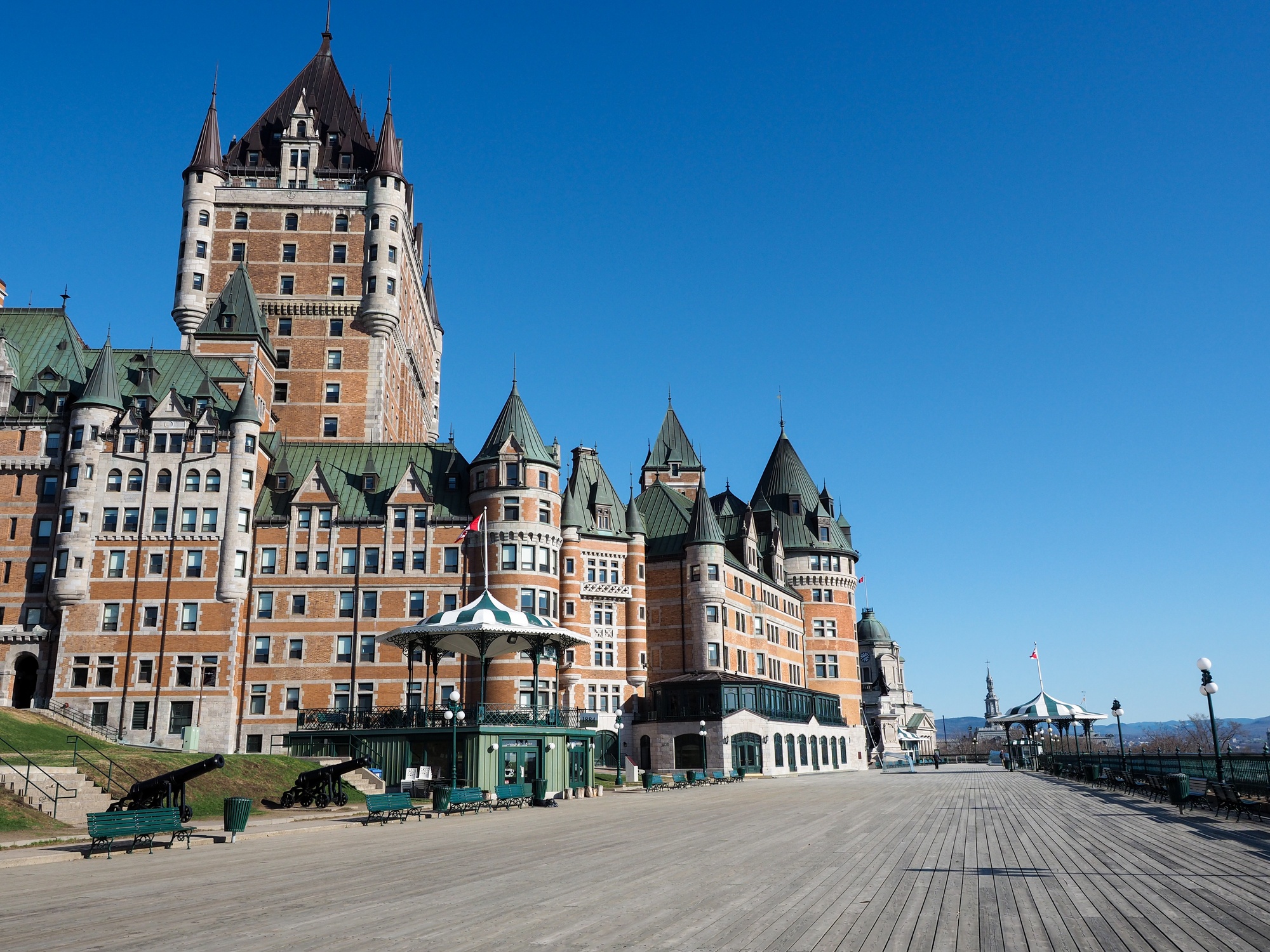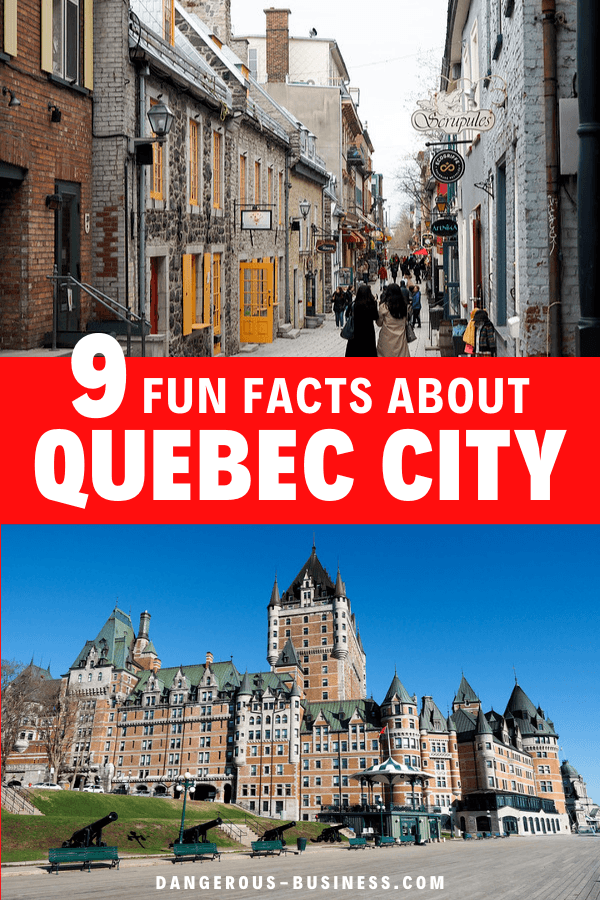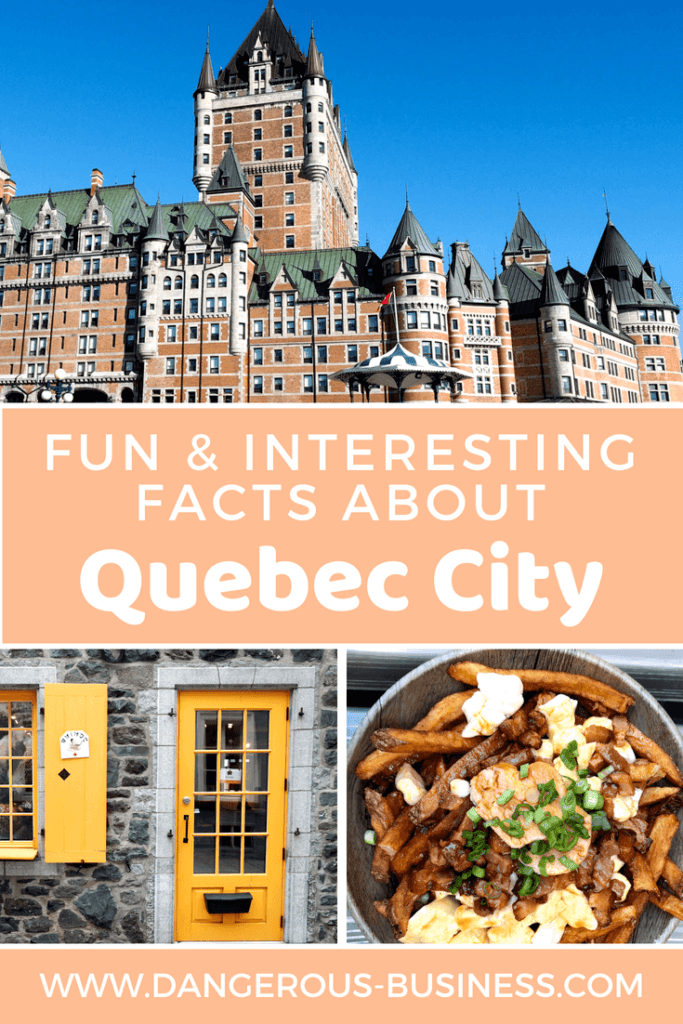Fun Facts: 9 Things You Might Not Know About Quebec City

Most people assume that if you want a taste of Europe, you have to travel all the way to Europe.
And while this is *mostly* true, there's actually a city in Canada that will give you all the Europe feels without the Europe jet lag. And that city is Quebec City. (Their tourism slogan is literally “So Europe. So close.”)
I've been to quite a few cities in Canada, from Toronto to Vancouver to Ottawa to Calgary. But none of them feel quite the same as the cities in the province of Quebec. The Quebec region has a history quite different from the majority of the rest of Canada – and there's no better place to get a feel for that history than in Quebec City.

I visited Quebec City for the first time in 2018. It was still chilly in early May and the trees were still bare and brown, but I absolutely fell in love with the city anyway. From the history to the architecture to the food, it's hard to NOT be wowed by Quebec City.
To further convince you to visit Europe in Canada, here are some photos and fun facts about Quebec City:
9 Fun facts about Quebec City
Here are some basic facts about Quebec City:
- Quebec City is the capital of the Canadian province of Quebec.
- French is the main language spoken in the province, and also in Quebec City.
- The city's name is Ville de Québec in French.
- The city's name comes from the word “Kebec,” which is actually an Algonquin word meaning “where the river narrows,” reflecting the fact that Quebec City sits at the narrow confluence of the St. Lawrence and the St. Charles rivers.
And now here are some more in-depth interesting facts about Quebec City:
1. 400 years of history
Quebec City celebrated its 400th anniversary as a city in 2008. The spot that would one day become Quebec City was officially “discovered” by the French explorer Jacques Cartier, who built a fort there in 1535 and attempted to build a permanent settlement in 1541. (Though of course there was an Indigenous population in the area before that.) The settlement failed within a year, but it wasn't long until another attempt was made.
In 1608, Samuel de Champlain showed up to properly settle the area. He built not only a fort and trading post, but also a residence in what is now Place Royale in the lower old town. This was the beginning of Quebec City, the first permanent settlement to be established in Canada.
2. French culture in Canada
This part of Canada is often referred to as “the cradle of French civilization in North America.”
Especially in the lower old town around Place Royale and Rue du Petit-Champlain, the French influence on Quebec City can easily be seen in the architecture and cobbled streets. Walking around this part of the city, you absolutely feel like you're in Europe.

And of course everywhere you go you hear French being spoken. In Quebec City, more than 95% of the population is French-speaking.

(But don't worry – almost everyone speaks English, too, and Quebecois people also embody the Canadian stereotype of being super nice, so being a non-French-speaking tourist in this city is very easy.)
3. Almost a US colony
Even though Quebec City was settled by the French, the region changed hands a couple times over the years. The Battle of the Plains of Abraham in 1759 (part of the Seven Years' War) saw France lose its claim to Quebec (and the rest of Canada) to the British.
Not long after, in 1775, American troops led by Benedict Arnold attempted to invade and take over Quebec City in the Battle of Quebec to “liberate” the region from the British. The siege was unsuccessful, however, and Quebec did not become the 14th colony; instead, it remained under British rule until Canada became its own country in 1867.
4. UNESCO World Heritage Site
Because of its rich history and notable architecture, the oldest part of Quebec City was named a UNESCO World Heritage Site in 1985 for its “outstanding universal value.”
From UNESCO:
The Upper Town, built on the cliff, has remained the religious and administrative centre, with its churches, convents and other monuments like the Dauphine Redoubt, the Citadel and Château Frontenac. Together with the Lower Town and its ancient districts, it forms an urban ensemble which is one of the best examples of a fortified colonial city.
5. City walls
Part of the reason Quebec City gained UNESCO recognition is thanks to its city walls. These walls – covering 4.6 kilometers – were built mostly by the French in the 17th and 18th centuries for defense purposes. Today there are 4 gates, 3 towers, and the Citadel, which was actually built by the British after they took over the city (and, fun fact: the Citadel at Cape Diamond is still an active garrison today).
After the British military left Quebec City in the late 1800s, local politicians wanted to tear down the city's walls. Ironically, it was an Englishmen – Lord Dufferin, who was Governor General of Canada at the time – who persuaded them to not only save the walls from destruction, but also to restore them and promote them as a tourist attraction. Good thing he did!
Today, Quebec City is the only North American fortified city north of Mexico, and the walls see more than half a million visitors per year.
6. Most-photographed hotel
If you've seen photos of Quebec City before, you've probably seen an image of the Fairmont Le Château Frontenac. It looms large and castle-like over the St. Lawrence River and Dufferin Terrace, looking for all the world like the Canadian version of Hogwarts.
While many people expect to learn that this place was indeed a castle at one point, it was actually purpose-built to be a hotel from the beginning! Construction on the chateau-style hotel began in 1892; it was one of a series of similar hotels built by and for the Canadian Pacific Railway as waypoints along their routes in an attempt to lure wealthy travelers to its trains.
Additions have been made to the Château Frontenac over the years, and now it houses more than 600 rooms, multiple restaurants, and spa, and even a Starbucks. Once you see it for yourself, it's easy to understand why the Château Frontenac is usually regarded as the most-photographed hotel in the world.
7. The Catholic Church in Canada
Since Quebec City was originally settled by the French, it's understandable that the city and province has always had ties to the Catholic Church. The Notre-Dame de Québec Basilica-Cathedral in the city's Old Town is the oldest Catholic parish in North America; the Basilica-Cathedral stands on the same site it's been on since it was first built in 1647.
Inside, Notre-Dame de Québec has a golden baldachin over the altar and tabernacle that looks like a miniature version of the one in St. Peter’s Basilica in the Vatican. It's also home to the only Holy Door outside of Europe.
8. A legacy of education
I highly recommend a walking tour of Quebec City in order to learn about the city's legacy of eduction. For example, there's the Séminaire de Québec, which was founded in 1663 as a seminary school. It became the Université Laval in 1852, and is regarded as both the oldest educational institution in Canada and the first French-language university in the Americas.
Not far away, you can find the Ursuline Convent, which has been occupied by Catholic Ursuline nuns since 1642. The Ursulines founded North America's first school for girls here in Quebec City, which is pretty cool!
9. A foodie haven
While Quebec City itself doesn't lay claim to it, the larger Quebec region is regarded as the “home” of poutine. Poutine, for those who aren't familiar with it, is basically just french fries topped with squeaky cheese curds and brown gravy.
You can get all different types of poutine in Quebec City, including versions topped with other things like foie gras, chorizo, or even pulled pork.
Along with poutine, you can also find great seafood and French-inspired dishes all across town. I did not have one bad meal in Quebec City!
And this list of course doesn't even begin to cover all of the things you can DO in Quebec City. Along with enjoying all the architecture and food, you can also visit nearby Montmorency Falls, take a ferry over to Lévis, explore Battlefields Park and the Plains of Abraham, visit the Citadel, explore the Old Port market, and much more!
Here are some Quebec City tours to check out:
- Quebec City Walking Tour
- Small-Group Quebec City Food Tour
- Quebec City Historic Discoverers Cruise
- Island of Orleans Food and Drink Tour
Who's inspired to visit Quebec City now? Did you learn anything new from this post?
Pin it for later:

Amanda Williams is the award-winning blogger behind A Dangerous Business Travel Blog. She has traveled to more than 60 countries on 6 continents from her home base in Ohio, specializing in experiential and thoughtful travel through the US, Europe, and rest of the world. Amanda only shares tips based on her personal experiences and places she's actually traveled!























Quebec is a great place to visit! In my opinion, the best time to visit is during the winter carnival in February!
Yes I’ve heard that’s amazing! I also think the city must be pretty magical when it’s all dressed up for the holidays.
It’s a lovely city. I did not know that Quebec is so colourful like this. I admired the architecture and especially the roofs of the buildings.
The architecture is so pretty; definitely made me feel like I was spending the weekend in Europe!
Those are really fun facts. Now I want to visit Quebec.
Very inspired to visit Quebec…love the architecture.
Quebec really does look a lot like cities in Europe. It even has a bit of the “small town” feel in the photos you took. I love that about a big city. Poutine is incredibly high on my list of food to taste, that’s enough reason for me to visit Quebec 🙂
I loved that the city center is so walkable – it definitely made it feel like a smaller city!
I was at WITS, I’m from Toronto, and I did not know a significant portion of those facts or information nuggets haha! This is great! Also, I’m not sure how, but you managed to make poutine look delicious. It’s usually one of those ugly-delicious foods, but that last photo has me headed to the fridge for some cheese n crackers!
Haha you’re right – that one is a really good-looking poutine!! Precisely why I took a photo of it. 😉
I’ve been to Montreal before and I absolutely loved it. I would love to check out Quebec City too!
I highly recommend it! I have a feeling I’ll definitely be back to see (and eat) more!
Although I’ve never been to Quebec City, I visited Montreal in April. I could also see the European charm. It reminded me of New England,USA, which is where I am from (Connecticut). I just love the architecture in Quebec. Thanks for the post.
Montreal is great, too. But I think Quebec City is even more European-feeling!
Quebec is by far my go to Canadian destination!! I recommend everyone goes and checks out these places!
I can’t believe it took me so long to visit for the first time!
This is awesome! Now I’m longing for a place I’ve never been. At least with your tips when I do get there I can hit the ground running!
If you’re longing for a place you’ve never been, then I’ve done my job right as a travel blogger!
beautiful city, if I ever visit Canada this would be my first port of call:)
There are cruises to this part of Canada, too, if you literally do want to make it a port of call! 🙂
Fascinating Amanda! I had no clue Quebec City had such a European feel. I knew it had a strong French influence, with many locals speaking French, but had no idea the place was THAT much a European town. Neat to know. Adding to my travel list when I do a proper Canada trip. Good jet lag point too 😉 Thanks for sharing!
Ryan
Most of the city center totally feels like Europe instead of Canada!
I definitely agree that if you want a taste of Europe, Quebec City is the place to go!
I first visited on a school trip in grade 9 because I was in a French Immersion program and that is where we would get to really use our French, and learn about the history too of course. Even at 14 I fell in love with the architecture, history, and the feel of the city.
We returned to Quebec City (and Montreal) a couple of years ago and had a wonderful time again. We visited in November so was a bit chilly, and we even got snow one day, so I’m looking forward to returning again in the spring and summer to see it all in bloom.
And the poutine… oh yes. So full of calories, yet so, so delicious!
There were lots of school groups in Quebec City when I was there (apparently May is the month for those trips!), and I thought that was so cool; the perfect place to go to practice French without having to go all the way to France!